
Roy Thomas- repped by his omnipresent manager John Cimino- admittedly falls into the “doesn’t need an introduction” category, such has his long tenure been in the world of comics these past six decades. What is generally glossed over and seldom explored however is his changing timeline, the alternate realities of his career, his blatant retcons of experiences and feelings for collaborators and publishers alike. Has anyone changed his story as much as Roy Thomas? And is that somehow fitting for both a continuity hound and a blatant opportunist such as the man once called The Rascally One?
The origin story of Roy Thomas is well established, from his days as prominent fanzine publisher to his entry into the comic book industry. What especially struck me of late is his convention schedule, impressive as it is for a man over eighty. Accompanied by Cimino, his con adverts purport him to be “Stan Lee’s chosen heir” and “Stan Lee’s first protege!“. While that is fundamentally true in theory– clearly Lee was going to guide a new hire that he wanted to abide by and enforce his system of having artists write the stories- it’s a relatively new credit that Thomas has excitedly latched onto. Only since 2018 has this been so prominent a part of his publicity. Could it be because Cimino and Thomas realized the lucrative convention market was missing that prominent Stan Lee booking that inevitably brought out droves of MCU devotees happy to shell out big bucks for an autograph and photo opp? I believe so. Well, what’s the next best thing?

Thomas’s changing narrative befits him, such is his notoriety within comics fandom for originating the retcon and generally devoting entire arcs of storytelling to continuity within the respective universes he worked in. Another curious facet of this- and yes, a remarkably recent one at that- is that Thomas is now, amazingly, billed as the co-creator of Wolverine and Storm, among others. While Thomas has spoke of his involvement previously in being a catalyst towards these characters creation, in the past couple of years he has been heavy handed in taking equal co-creator credit. An article that appeared the week of this writing featuring Thomas touted “Wolverine co-creator” reacting to Hugh Jackman’s comics-centric costume in the upcoming Deadpool film. Why this change? Let’s examine a few quotes of Thomas that may emphasize just how curious the sudden evolvement in Thomas’s view actually is:
“Was it true that you suggested a character named ‘Wolverine’ to then HULK writer, Len Wein?”
“Well, Dave Cockrum says he once mentioned a character named Wolverine to me, but it doesn’t make much difference as a name, because we were doing so many animal names anyway…. the one thing I know is I considered two names at the time, either a wolverine or a badger. I wanted some mean, northern animal so we could have a Canadian character. I didn’t go much beyond that. … he wasn’t necessarily a mutant.
The I gave the idea to Len, and he did everything else with him. So, in a sense, I was one of the creators of Wolverine but on the other hand, it was only in a general sort of way… I don’t want to make too much out of it, because someone would’ve come up with something like him anyway.”
– Roy Thomas, Comic Book Marketplace May 1996
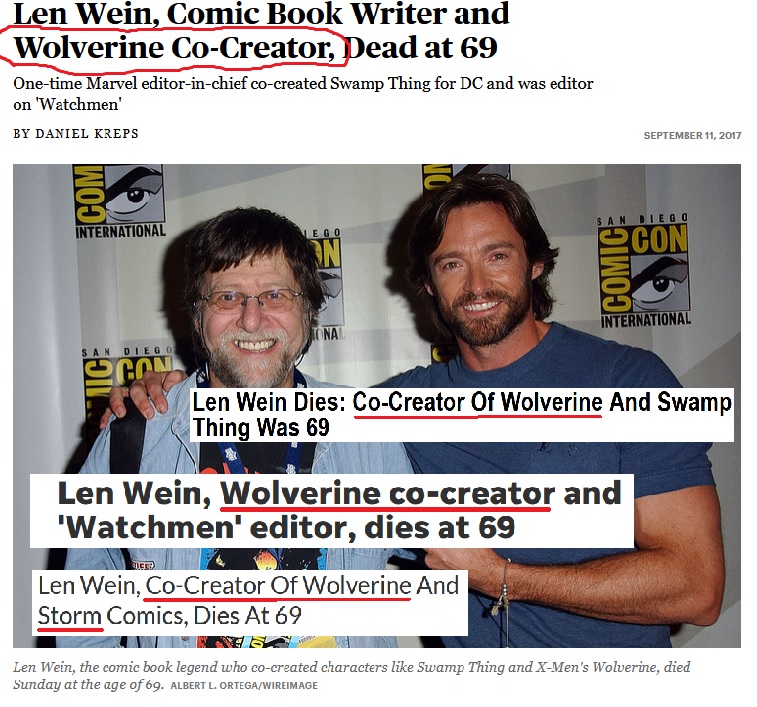
When Len Wein passed away, mainstream and comics centric media alike rightfully credited him as the co-creator of Wolverine. Roy Thomas was barely mentioned if at all and notably did not chime in with his involvement of suggesting a Canadian character who may not have been a mutant, etc. It was actor Hugh Jackman who flew Wein out to the premiere of his Wolverine solo film, such was his gratitude for Wein’s involvement as a catalyst for Jackman’s career. So the very visible Thomas as Wolverine co-creator is an extremely new development in the narrative of Thomas’s career. Let’s look at another choice quote of Thomas involving his belief on what constitutes a creator:
“I remember Stan and I got into a good-natured argument ten years ago in L.A. I wasn’t even working for Marvel at the time, and we had lunch. He talked about people like Stephen J. Cannell and television, saying if Cannell comes up with a general idea, and wants a few people running around doing this and that, and calls them the A-Team, he’s created that. It says “Created by Stephen Cannell.”
And I said yes, but that’s a function of power, not of creativity. It means Stephen Cannell has the power to say he created that thing alone, and other people buy into that by agreeing to sell their work for work-for-hire, or for other financial deals. But it doesn’t mean he really created the whole thing just because it says so on paper. That’s a legal thing. It’s caused by his power; you either play by his rules or you don’t play. It doesn’t mean he really created the A-Team all by himself.
TJKC: How did Stan react to your point?
ROY: I think we agreed to disagree in a friendly way. – January 1998
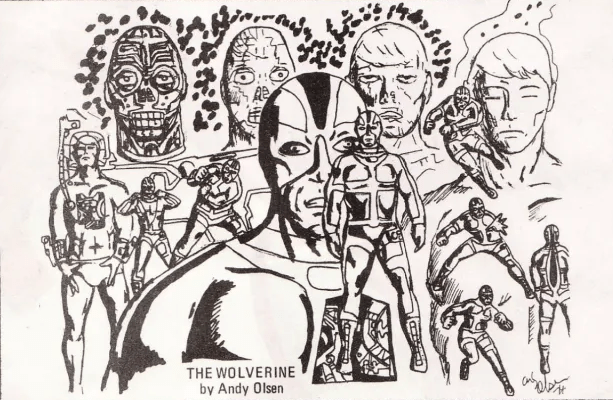
Six months before Wolverine appeared in The Incredible Hulk #180, the Marvel fan-magazine FOOM #2 came out in July of 1973. It contained the results of a contest Marvel held, “Create a New Marvel Super-Hero” contest- a contest which contained the entry of one Andy Olsen. His character? The Wolverine.
Much has been written over the years about this remarkable coincidence. None other than Marvel Editor and corrupt man-child Tom Brevoort said of Olsen’s Wolverine, “I seriously don’t think that Roy Thomas, Len Wein, John Romita and Herb Trimpe needed any help in coming up with a super-character based on an existing animal. So it’s simply a coincidence.”
Brevoort- who, it occurs to me, may have been the inspiration for Thomas’s “Oort the Living Comet” character- diverts by using a tactic which implies that anyone suggested that Thomas, et. al needed any help. This was never stated by anyone. The implicit belief is that Thomas saw a Wolverine and took that name and notable element to be passed off to Wein, etc. And if that sounds far fetched…? Consider this… significant aspect of Olsen’s Wolverine entry: character has a “bionic skeleton.”
bionic skeleton…. bionic skeleton…. bionic skeleton….. Wow! That is a coincidence.

So, Thomas has evolved into a position where he eagerly and happily laps up being seen as Stan’s fair haired boy and the co-creator of Wolverine and Storm simply from suggesting some international characters for the Seventies X-Men reboot. I would like to hereby suggest that, going forward, we invoke what I am calling The Goodman Rule: that any Editor that suggests vaguely a character, or group of characters- becomes the de-facto co-creator. This now makes Martin Goodman the co-creator of The Fantastic Four, for directing Stan Lee to start a “team” book, based on recent sales of DC’s Justice League comic. You’re welcome.
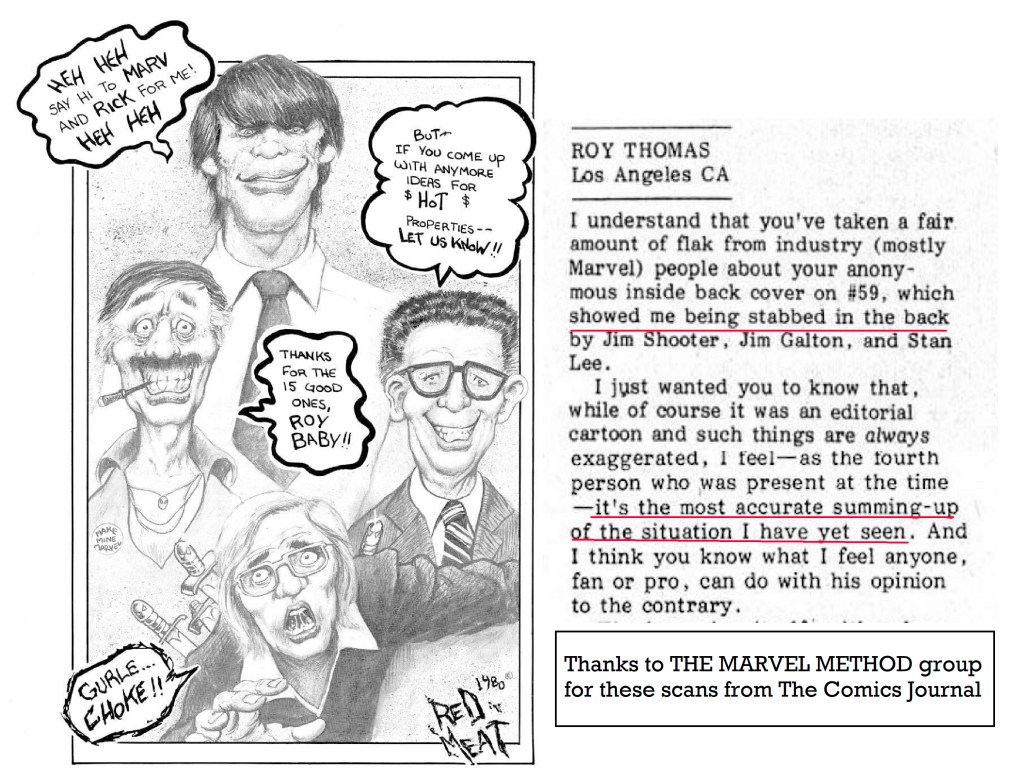
And what made this path to heir and co-creator so especially curious? To know this, we need to look at Thomas’s history of contradictory and changing statements, of which there are many for Thomas has been especially outspoken at every perceived slight he has ever received within the comics industry. A prolific letter writer and interview subject, it’s especially and valuably worth noting how venomous Thomas was in 1980, shortly after he departed Marvel due to disagreements with then Editor-in-Chief Jim Shooter- this excerpt above is from an editorial cartoon from The Comics Journal, a cartoon which moved Thomas to write in to add his approval of. (Also compare this to Kirby’s Funky Flashman throwing Houseroy to the wolves- and Thomas’s verdict of that as “mean-spirited!”)
I find it crucial for context to examine some of the many statements Thomas made about Jim Shooter in order to properly illustrate the curious path his career made later on.
Roy Thomas: “I think it’s a shame that a comics company is run that way, but that’s Marvel’s fault. I’m no longer there, so I don’t care. I just feel people ought to know what’s going on.” — Comics Interview #6, August 1983
Roy Thomas: “I never had the same feeling of real loathing for anybody else at Marvel that I’ve felt for Jim Shooter. I have no respect at all for Jim Shooter as a professional.” (“Shooter, Our Nixon” The Comics Journal, 1994)
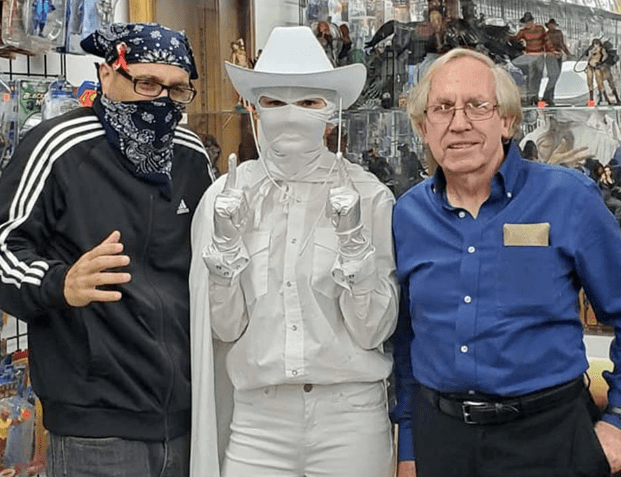
Thomas was beyond outspoken about the apparent villainy of Shooter, even chiming in when other creators shared their own experiences at Marvel and eagerly writing in to publications such as Comics Interview when it covered the failure of the Avengers/Justice League crossover. Thomas had moved to DC with all of the fanfare accompanying such a significant “get” from Marvel and had every reason to believe that he was affirmed as a star of the industry with his new employer, so likely felt secure in speaking out about his various grievances. As we’ll see however, the bloom quickly wore off at DC and it had an astonishing effect on Thomas’s outlook…

“I suppose this sounds as if, for me and DC, the honeymoon was over pretty fast….”
“They (DC) just didn’t bother to pay me that courtesy. It was just another nail in the coffin of my relationship with DC. In fact, if my relationship with DC had a soundtrack, it would mostly be the sound of nails being driven into a coffin.”
“At the turn of 1983, I was indeed the editor… I think, because of some politicking that was going on that in the end Dick (Giordano) didn’t feel he could or should resist- guys like Gerry (Conway) and I were redesignated as “story editors”… put a kind of firewall between our being able to choose or direct artists. I remember Dick telling Gerry and me once, that things had gotten a bit tricky at DC and that Gerry and I should “watch your back”… what the hell was that supposed to mean?”
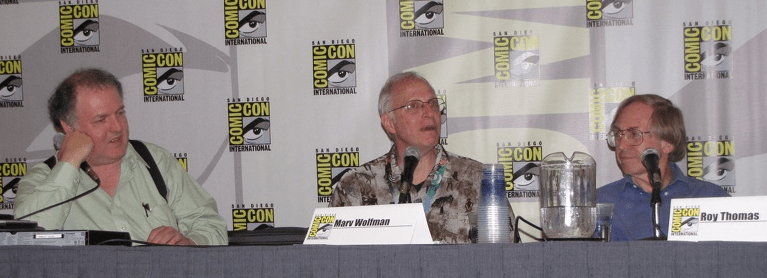
“I loved the characters, and I liked a lot of the people. I just hated the politics of the place.”
“It’s the classic Catch-22, as defined by Joseph Heller: “They can do anything you can’t stop them from doing.”
“On Last Days of the JSA, I got double-crossed yet again…”
The blog Witless Prattle mentioned that, during the Crisis storyline, Thomas was so demoralized and upset with DC that his attitude began to leak into the letter pages of the series he wrote. While I don’t have access to back issues of Young All-Stars at the moment for specific examples, I felt this was worth noting as a general example of Thomas’s demoralized mindset:

“I guess there always are problems in comics, but it seemed to me like there were far more of them at DC than there’d be at Marvel.”
“It was virtually a two-company field then, and I couldn’t go back to Marvel because of the situation with Shooter… I continued to get some work from DC for two or three years after my contract ran out in late ’86… I liked working with their characters, but I no longer cared about DC as an entity… they’d pretty much cured me of that.”
“At some stage in the second half of the ’80s- I wrote a two-page letter to Jim Shooter because I’d decided things weren’t going that well at DC…”

Say whaaatt?? Thomas wrote a letter to Jim Shooter, the very man who he claimed had run him out of Marvel..?? This is an unexpected turn of events! Certainly not Roy Thomas, who had endorsed the narrative that he had been backstabbed by Shooter, Galton and his apparent mentor, Stan Lee??
(Now, it’s time for a very quick sidebar. And yes, I’m aware this entry is jumping around the timeline a bit, but for someone who has changed realities as much as Thomas, it’s somewhat fitting. For someone who speaks of loyalty, it’s worth noting that Thomas, behind Stan’s back, sought out Martin and Chip Goodman in 1974 after they had launched Atlas-Seaboard Comics, at the cusp of their better-deals-for-creators campaign.

This is important to mention since, in the late nineties, Thomas changed the story when interview in Comic Book Artist to say that Martin & Chip Goodman sought him out. It’s a funny thing about having a record to cite- and a bit hard to retroactively change.)
Listen, it’s relatable that someone who needs work is willing to compromise a bit in order to keep the roof over their head. But it’s somewhat grating that Thomas, so entitled and so selective in his overall morals, suddenly changes his entire value set because DC wasn’t the paradise of creator freedom he assumed it was. (There’s also something to be said about Thomas going to DC because he thought it would hurt Marvel.)
So, Thomas makes the overtures to write to his former nemesis, Jim Shooter. A man that he routinely maligned in the press (while Shooter held his tongue). Actually, I should amend this- I’m just discovering the first letter was from 1984 (!) when Thomas is still actively working at DC Comics. So already, he wasn’t hedging his bets:
“Dear Jim,
Despite disagreeing considerably with a number of points you make in your letter of April 9 (as you obviously did with some of mine, made in the previous letter), I was glad to see we’re not really all that far apart.
For my own part, as I tried to make clear, I have made a solemn vow (to myself) to let bygones be bygones, and if possible, to avoid adverse comment on Marvel and its policies. I’ve even long regretted the fact that your elevation to the position of editor-in-chief, in which you’ve obviously done a fine job, came at a time after I’d moved to the West Coast. Perhaps if we’d had more personal communication from 1977 to 1980, we could have come to some sort of agreement at that time or at least parted under more amicable circumstances. I leave it to you to decide if we should ever make any attempt to rectify that situation; certainly I’ve never been a grudge-carrier in other cases, and our differences– if we ever sat down and talked about them — are hardly insurmountable, even if we never happen to work for the same company at the same time again.” (May 14th, 1984)
And, after his tenure at DC is finally concluded: “I’ve long regretted that our different (and both quite reasonable in their varying ways) objectives in 1980 led– perhaps inevitably– to a break ‘twixt Marvel and myself, and I regret some of my own more extreme actions at the time. I’ve been impressed by your professional ability to let bygones be bygones, including letting Stan’s Soapbox “plugging” me to be printed, and I’d like to think I’d have done the same, were our positions reversed.” (March 11th, 1987)
Wow. I can’t remember who, but a comics professional once referred to Thomas either in jest or insult as “The Super Adaptoid” and I’m starting to get it now. Thomas has adapted so well and changed his stance so often once must give him begrudging credit. He did end back up at Marvel but found that the status he enjoyed throughout the Seventies didn’t survive into the late Eighties and early Nineties. While one thinks he may have now understood how Jack Kirby felt when he returned to Marvel at one point, that’s giving the self-absorbed Rascally One more credit than he is capable of receiving. Thomas’s later career is a series of diminishing returns. And when he is given opportunities at Marvel, such as a four issue mini-series featuring the Invaders, he can only complain that he wasn’t given six issues.
Eventually, the work dries up at Marvel. So what does Roy do, in desperation? Why, he turns to the former back stabber. He turns to his apparent mentor, Stan Lee.
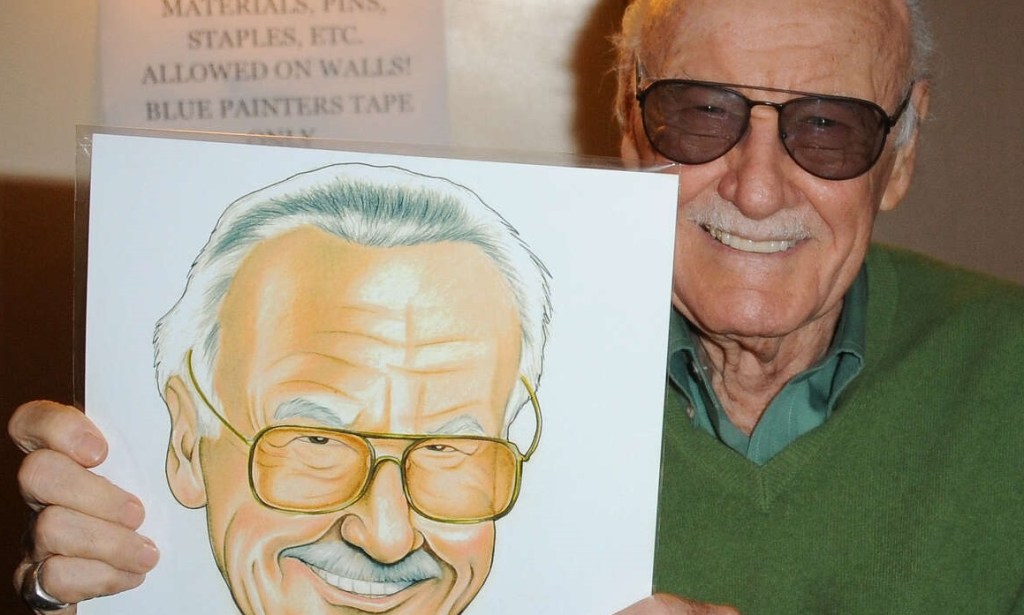
“Back in 2000… I wasn’t really doing that much in comics so I thought, well, maybe Stan would have something. I got in touch with him- he said he pretty much had to work with people who were right there on the scene for various projects. But he said that he did have something else for me- that was, he could use a writer- a ghostwriter basically, or ‘someone to help him with’ would be how he might phrase it, but I knew what he meant– the Spider-Man newspaper strip. He said he’d had someone else working with him for the last story or two, and I guess he’d had other people before, like Jim Shooter.. I knew Jim Salicrup was working with him at the time, but he said he had a lot of other stuff for Jim to do, and he asked if I would be interested in taking it over.” (Roy Thomas, July 2022)
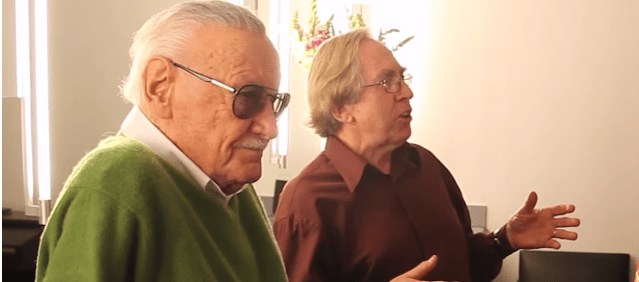
The prodigal son returned. Thus began another secure part of Thomas’s career- that of Stan ghostwriter and defender. It would be as profitable as it would be prolific. And then, with Stan’s departure from the stage- what then? It was only natural that an heir apparent would take his mentor’s place as the face of editorial creatorship. Who then, to facilitate this next stage of the Rascally One’s vibrant career?
Enter John Cimino. A man so misguided in his worth that his appearance on this blog will give him a healthy dose of self-satisfaction. A man who, in his fifties, actually subscribes to the saying “haters are my motivators.” It isn’t that Cimino doesn’t perform his managerial duties, at least not that I’m aware of. It’s that suddenly, getting Roy Thomas meant getting a 2-for-1 package. Cimino began appearing as a veriable second guest when podcasts or shows booked an interview with Roy. His old Hardcore band began to be mentioned prolifically for some reason, in the pages of Alter Ego. Every article that involved Roy would literally mention Cimino two-three times on average. I even found it curious that a recent Q&A article with Thomas- one that is simply an interview with Thomas alone- felt the need to include a bio of Cimino at it’s end.
I have been told by someone who hosts a prominent show which frequently interviews creators that “Roy insisted” on Cimino’s appearance. On one show, Thomas and Cimino wore matching shirts and Cimino refers to them as “The Roy Boyz“. I’m not being sarcastic when I say I’m almost charmed at the apparent camaraderie between these two. Did Roy feel regret over never having a son? Did he just not have any friends in adulthood? Whatever his reasons, he has made a point to have Cimino’s name prominent in most current things he does.
So when you get a Roy Thomas guest spot? You inevitably get The Cimino, to boot.


Cimino is so notorious that- apparently- someone once impersonated him on a forum, leading to the- apparently- real Cimino showing up, breathlessly imploring the moderator that this was a FALSE John Cimino. Hey, maybe he is somebody, after all? Unfortunately, the notoriety stems from a sad incident in which a giggling Cimino took a photo of elderly Steve Ditko when Ditko was leaving his building- Ditko, long famous for asking not to be photographed. As Ditko was never enamored with Thomas, one suspects he didn’t scold his ward for his disgusting behavior.
So there you have it, presented in somewhat convoluted manner- but isn’t that always the case with changing timelines? Roy Thomas is a secondary talent with vile ambitions and wavering loyalties. He has contradicted himself in print countless times. He has stolen ideas and stolen credit. And perhaps worst of all, when he departs this mortal coil, he’ll have left us John Cimino, presenting his doofus face and lack of accomplishment, at a majority of comic conventions. The Grand-heir of Stan Lee, perhaps? Stranger things have happened.

My actual thanks to The Marvel Method group, Jon B. Cooke, Michael Eury and Jim Amash as well as the author of the Witless Prattle Blog.
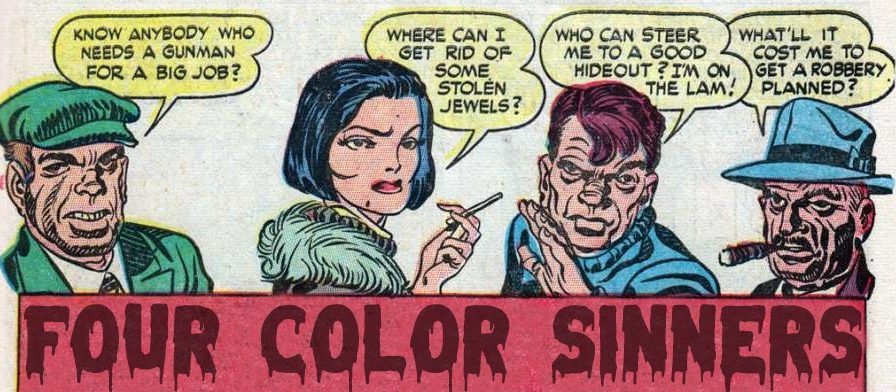
As far as Martin Goodman being co-creator of Fantastic Four, you may want to consider Roy Thomas instead. It was in or about 1970, after Kirby’s departure from Marvel, that the JLA story first broke. You say Thomas wasn’t even there when the FF were created? Well, it was pretty close! He had a review published in September 1961, the month *after* FF #1 hit the stands. In it, he used the magic words Justice League of America. (Admittedly he also compared the FF to the Challengers of the Unknown, but for the purposes of this story that’s an extraneous detail.)
Let’s say for the sake of argument that Goodman was oblivious to the JLA origins of the FF and was just convinced to try superheroes by Kirby. Lee *had* to have a co-creator, didn’t he? Thomas, in reaching back to within a few months of the actual creation to his *actual words* at the time, was in effect co-creating when he established a narrative crediting the creation to Lee that eventually became the accepted history as told in Origins of Marvel Comics. You may say, yeah, but doesn’t proof have to come from *before* the actual creation? Hey, are you going to quibble over a few months? C’mon, the only *physical* evidence says Lee was only involved as an afterthought; who are you going to believe, the evidence, or the two guys who co-created the creation story?
“Back in 2000,” Thomas decided to turn to Lee. Why don’t we be more generous and call it 1998? In 1998 just before Ike Perlmutter had Lee fired, Thomas was tapped as the conduit to rehabilitate Lee’s reputation after the devastating Kirby art debacle and that nasty TCJ interview. Thomas’ strategy was a tell-all article in Alter Ego ostensibly authored by Lee, in which Lee confessed to having typed up his FF “SYNOPSES” [sic] *before* he brought the idea to Kirby. This cancels out Thomas’ own confession of a few months earlier that Lee *wouldn’t* say he did it before speaking to Kirby. On the flip side of the magazine in that month’s Comic Book Artist, Thomas conducted an “interview” with Lee in which he spoon-fed Lee the new narrative and had Lee responding with “that’s absolutely true!” The Spider-Man newspaper gig was two years later and came with no overt credit: it could in no way be considered compensation for that service. Thomas probably had something grander in mind like the SLMI vice presidency Lee bestowed on Thomas’ old ’60s fanzine debate nemesis, Mark Evanier. Ah well, at least he gets the last laugh of being able to carry on as Lee’s stand-in on the convention circuit.
LikeLiked by 1 person
From the above, it’s clear Michael Hill understands the concept of “heavy sarcasm”.
LikeLiked by 2 people